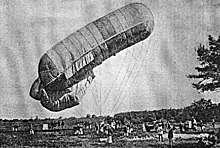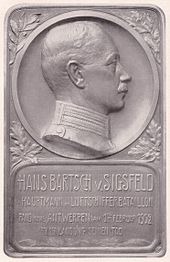Hans Bartsch von Sigsfeld
Rudolf Max Wilhelm Hans Bartsch von Sigsfeld (born February 9, 1861 in Bernburg (Saale) , † February 1, 1902 in Zwijndrecht , Belgium ) was a German inventor and airship operator. Together with August von Parseval , he developed the dragon balloon .
Life
Hans Bartsch von Sigsfeld was the son of a Anhalt forestry and hunter master of the same name (1813–1884). His mother Amalie (1822–1917) was the granddaughter of Johann Gottfried Herders . Bartsch von Sigsfeld attended the Karls-Gymnasium in Bernburg as well as the grammar schools in Zerbst and Greiz , where he passed the Abitur. He then studied engineering at the Technical University of Charlottenburg . In 1882 he completed his one-year conscription with the 2nd Guard Uhlan Regiment and then remained a reserve officer .
Bartsch von Sigsfeld joined the German Association for the Promotion of Airship Travel in 1887 . There he got to know the meteorologist Richard Assmann , with whom he constructed an aspiration psychrometer until 1892 , with which it was possible for the first time to reliably measure the temperature during balloon flights. Together with the meteorologist Victor Kremser , he tested an early form of this instrument in 1888 during an ascent with his Herder balloon, which he built at his own expense .
In 1889 Sigsfeld moved to Augsburg and Munich . There he was a co-founder of the Munich Association for Airship Travel. In the fall of 1889 he founded a test workshop for aviation with the Augsburg factory owner August Riedinger . Their goal was the construction of a steerable motorized airship . From 1890 August von Parseval also took part in the work. With him, Sigsfeld developed the kite balloon, an elongated tethered balloon with an airbag , which - in contrast to the tethered spherical balloon - is not pressed to the ground by the wind, but lifted. In 1893 they patented this invention and offered it to the Prussian military as a means of battlefield reconnaissance . In 1897 the first kite balloon left the Riedinger balloon factory.
From afar, Bartsch von Sigsfeld took an active part in the Berlin scientific aviation carried out by the Association for the Promotion of Airship Travel. After the Humboldt club balloon, which was filled with hydrogen, was ignited by an electrostatic discharge on April 26, 1893 , balloon envelopes were impregnated with 10% calcium chloride solution at his suggestion in order to make them permanently electrically conductive. In 1896 Bartsch returned from Sigsfeld to Berlin, gave up his civilian profession and entered the active military service in the airship department in Berlin-Tegel . In 1897 he went on a trip in the balloon condor with the film pioneer Oskar Messter . The first moving aerial photos of Berlin were taken. In March 1899 he set a German record for free balloons of 650 kilometers with a club balloon.
In the summer of 1897, Bartsch von Sigsfeld was commissioned to make use of wireless telegraphy, invented by Guglielmo Marconi , for the transmission of military messages. In cooperation with Adolf Slaby , who had previously attended Marconi's experiments, a radio link from Schöneberg to Rangsdorf was established as early as October 1897 . Both in Schöneberg and in Rangsdorf, 21 kilometers away, Bartsch von Sigsfeld had tethered balloons soar, the holding cables of which also served as transmitting and receiving antennas . At the time, it was the longest wireless distance in the world. As early as the spring of 1898, the range was increased to 60 kilometers (Berlin - Jüterbog ). For mobile use, Bartsch von Sigsfeld developed small tethered balloons that could just carry a cable several hundred meters long. According to his concept, eddy kites should be used in stronger winds. By 1900 it was possible to equip the airship department with two mobile radio stations , which proved themselves during the Imperial maneuvers in 1900 near Stettin. In 1901 a detachment headed by Bartsch von Sigsfeld moved to Strasbourg with two mobile stations to carry out further tests in collaboration with Ferdinand Braun .
From 1897 until his death in 1902, Bartsch von Sigsfeld was again involved in the construction of airships. During this time he also worked for Ferdinand Graf von Zeppelin in Friedrichshafen . From 1900 he was a teacher at the military airship school in Berlin. In 1901 he was appointed to the first military commission to examine the construction of dirigible airships and flying machines. Bartsch von Sigsfeld had a fatal accident with the Berson balloon near Zwijndrecht near Antwerp in a storm landing on frozen ground in 1902 , while his passenger Franz Linke suffered only minor injuries. He was buried on February 8, 1902 in Ballenstedt .
A year after his death, a memorial for Hans Bartsch von Sigsfeld, which the sculptor Hans Weddo von Glümer had made, was inaugurated on the barracks of the airship department in Berlin's Jungfernheide . A memorial stone that the German community in Belgium erected on March 6, 1904 on the Borgerweertpolder stands today at Steen Castle in Antwerp .
In memory of his services to aviation, the largest German gas balloon with a volume of 9,500 m³ was named after Hans Bartsch von Sigsfeld in 1927 . With this important scientific highs were undertaken.
Fonts
- Studies of the balloon material with special reference to the electrical behavior of the same . In: Journal of Aviation and Atmospheric Physics , 1897.
literature
- R. Börnstein : In memory of Hans Bartsch von Sigsfeld . In: Verh. D. German Physically. Ges. 4, 1902, pp. 88-97.
- von Kleist: Rudolf, Wilhelm, Max, Hans Bartsch von Sigsfeld. Captain in the Royal Prussian Airship Battalion. † February 1, 1902 . In: Illustrirte Aëronautische Mittheilungen 6, No. 2, 1902, pp. 54–56.
- Schulze-Manitius: On the 100th birthday of August von Parsevals and Hans Bartsch von Sigsfelds . In: Deutsche Flugtechnik 5, 1961, 115–116.
- Sabine Höhler: Aviation research and aviation myth . Scientific balloon flight in Germany, 1880–1910. In Campus Research, Volume 792, Campus , Frankfurt am Main / New York, NY 2001, p. 162. ISBN 3-593-36840-4 (At the same time dissertation at the Technical University of Braunschweig 1999).
- Peter Hennig: The wire rope was grounded with a saber. A decisive step was taken in Rangsdorf in 1897 on the way to wireless telegraphy . In: Märkische Oderzeitung , October 24, 2008.
References and comments
- ^ Franz Linke: Modern airship . Alfred Schall, Berlin 1903, p. 28
- ↑ R. Assmann: The working methods of the aerological observatories . In: Bröckelmann (ed.), Wir Luftschiffer , Ullstein, Berlin and Vienna 1909, p. 117.
- ^ Franz Häussler: The airship "Parseval" . In: Augsburger Allgemeine , September 29, 2009
- ^ Franz Häußler: Riedinger dragons all over the world . In: Augsburger Allgemeine , September 19, 2009
- ↑ Biography of Oskar Messter ( memento from March 4, 2016 in the Internet Archive ) on the website of the Federal Archives
- ↑ Record list (PDF; 33 kB) of the German Free Ballon Sports Association, accessed on September 10, 2019
- ↑ Karl Solff: The development of wireless telegraphy for the purpose of land forces during aeronaut Battalion in October 1897 to the end of 1904 . In: Telefunken-Zeitung 1, 1912, pp. 56–63 ( online )
- ↑ P. Supf : Bartsch v. Sigsfeld, Rudolf Max Wilhelm Hans. In: New German Biography (NDB). Volume 1, Duncker & Humblot, Berlin 1953, ISBN 3-428-00182-6 , p. 614 f. ( Digitized version ).
- ↑ A detailed description of the course of the accident can be found in: Franz Linke: Air-electrical measurements during twelve balloon flights . In: Treatises of the Royal Society of Sciences in Göttingen (NF) 3, Issue 5, 1904, pp. 48–57
- ^ Rudolf Max Wilhelm Hans Bartsch von Sigsfeld. Bernburg February 9, 1861 - Zwijndrecht district (near Antwerp) February 1, 1902 on the website “Memorial plaques in Berlin”, accessed on May 1, 2016
- ↑ Jean Laenens, Frans Van Humbeek: Ballonongeval in de Borgerweert on www.hangarflying.eu, accessed on August 27, 2015.
| personal data | |
|---|---|
| SURNAME | Bartsch von Sigsfeld, Hans |
| ALTERNATIVE NAMES | Bartsch von Sigsfeld, Rudolf Max Wilhelm Hans |
| BRIEF DESCRIPTION | German inventor and aeronaut |
| DATE OF BIRTH | February 9, 1861 |
| PLACE OF BIRTH | Bernburg (Saale) |
| DATE OF DEATH | February 1, 1902 |
| Place of death | Zwijndrecht , Belgium |


